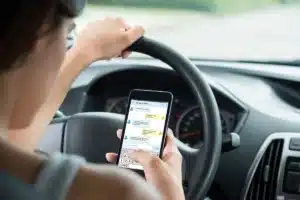California Distracted Driving Laws
Distracted driving is a form of negligence that puts all roadway users at risk of serious harm. As California natives with decades of experience handling accident claims, our knowledge of California distracted driving laws is unmatched.
- Distracted driving is any activity that diverts your attention from the road.
- Distracted drivers endanger all roadway users, particularly pedestrians and bicyclists.
- California’s cell phone laws ban wireless handheld communications devices while driving, except in limited circumstances, such as emergencies.
- The penalties for violating the cell phone laws include a fine, a point added to the driver’s license, higher insurance premiums, and civil liability for accidents caused by the distraction.
- Our experienced car accident attorneys can help recover compensation if you are injured by a distracted driver.
Driving a motor vehicle is a significant responsibility because it puts the lives of passengers and other roadway users into your hands. At the same time, your life is in the hands of other drivers. Regardless of how attentive you are, you could be severely injured by another driver’s poor choice to drive distracted. Understanding the distracted driving laws in California can help you build a strong case when a distracted driver injures you. A violation of the law provides concrete evidence of negligence that can strengthen your case.
Our experienced California car accident attorneys know the telltale signs of distracted driving. We can investigate your accident to determine whether a driver was distracted, identify which laws were broken, and build your case for you.
What Is Distracted Driving?
Distracted driving is any activity that diverts a driver’s attention away from the primary task of operating a motor vehicle. While many people associate cell phones with distracted driving, cell phone use is only one of the many forms of distracted driving. The range of activities that constitute distracted driving can be categorized as visual, manual, or cognitive distractions.
Visual Distractions
Distracted driving is any activity that diverts a driver’s attention away from the primary task of operating a motor vehicle. While many people associate cell phones with distracted driving, cell phone use is only one of the many forms of distracted driving. The range of activities that constitute distracted driving can be categorized as visual, manual, or cognitive distractions.
- Looking at passengers
- Looking at attractions or landmarks outside the vehicle
- Looking at a map
- Staring into space instead of watching the road
Visual distractions are among the easiest ways to lose focus when you are driving. For example, you could easily be taken in by the rolling hills, mountains, and coastline views in and around Santa Rosa. GPS is another common visual distraction, particularly in confusing areas, like Oakland’s hillside neighborhoods.
Manual Distractions
Manual distractions are activities that involve taking your hands off the wheel, such as eating, drinking, adjusting the radio, and smoking. Suppose a driver stops at In-N-Out Burger during their lunch break in Sacramento and eats a messy burger while driving back to work. Eating anything is enough to force someone to drive one-handed, but the driver will also likely struggle with food getting on their hands and clothing. They may fumble around with napkins, food packaging, and a drink all at the same time.
Activities that cause manual distractions often include visual distractions at the same time. In the messy burger example, the driver may be looking at their hands or clothing while using the napkins to clean up the mess. They may need to look at the burger to open the packaging or place the empty wrapper back in the bag. Even a simple task like adjusting the radio can be both a visual and manual distraction.
Cognitive Distractions
Cognitive distractions take a driver’s mind off the task of driving. This is sometimes called inattentional blindness. Although their eyes are open, a cognitively distracted driver isn’t really seeing the road because their thoughts are elsewhere. Cognitive distractions include talking to passengers, using a hands-free cell phone, and daydreaming.
Cognitive distractions can be just as dangerous as visual or manual ones. For example, a parent trying to calm siblings who are arguing or soothe a crying infant while driving on Interstate 5 in Los Angeles may fail to notice stopped traffic or construction barriers until it’s too late.
Most distractions during driving involve a combination of visual, manual, and cognitive elements. Texting is one of the most serious examples. During a text conversation, a driver is thinking about the conversation while looking at the screen and using at least one hand to type messages. This is always dangerous when someone is behind the wheel, but even more so on California’s busy streets and highways.
California’s Distracted Driving Laws
Every driver in California has a duty to exercise reasonable care to avoid accidents. This includes paying attention to the road, driving with both hands on the wheel, and avoiding distractions. When you are harmed because another driver was distracted, the distracted driving constitutes negligence, and the driver may be liable for your injuries.
Most of California’s distracted driving laws focus on the use of screens and electronics while driving. For example, it is illegal to have a television screen or other entertainment device with a screen within a driver’s view at any time while the vehicle is in operation.
GPS devices are allowed, but only if they are operated hands-free and mounted in areas allowed by law that do not obstruct the driver’s view of the road. State laws concerning mobile communication devices are similarly restrictive.
Mobile Communication Devices While Driving
California is a hands-free state. According to § 23123 of the California Vehicle Code, it’s illegal to use a cell phone while driving unless you are using it hands free with a system designed for that purpose. The phone must be mounted on the dash or center console in a manner that doesn’t obstruct the driver’s view of the road. Drivers may only use their hands to activate or deactivate a function with a single finger swipe or tap. California drivers under 18 cannot use a wireless telephone or electronic wireless communications device while driving, hands-free or otherwise.
There are a few exceptions to the California cell phone laws, which allow the following drivers to use handheld cell phones:
- Emergency services using wireless telephones while operating authorized emergency vehicles
- Schoolbus or transit vehicle drivers using wireless telephones for work or emergency purposes
- Anyone driving a motor vehicle on private property
- Anyone with an emergency purpose, such as calling law enforcement, a health care provider, the fire department, or other emergency services
There are no exceptions in the law for commercial drivers, rideshare drivers, or delivery drivers. These drivers must use hands-free devices except when one of the above permissible purposes applies.
2025 Hands-Free Law Update
The statewide handheld device ban covers all types of handheld cell phone use while driving, even if the phone is not being used as a phone. A California appellate court settled the issue in June 2025 in a case regarding a defendant who was ticketed for using his phone for navigation while driving in Santa Clara County. The defendant claimed he was using his handheld cell phone legally because he wasn’t operating it. The lower court agreed, but the appeals court reversed the ruling and determined that operating a wireless telephone includes viewing an app.
What are the Penalties for Distracted Driving in California?
The penalties for distracted driving in California can be severe for a distracted driver who causes an accident. Such a driver could be responsible for the injured party’s medical bills, pain and suffering, and other damages. The driver can also face tickets for other infractions caused by the distraction, such as speeding, reckless driving, or failure to yield. If the distraction involves a cell phone, the driver can also receive a cell phone ticket, with separate fines and penalties.
Fines for Violating the Statewide Handheld Device Ban
Violations of the hands-free cell phone laws are infractions that incur a base fine of $20 for the first offense and $50 for subsequent offenses. Traffic fines in California are accompanied by additional assessments and penalties, including the following:
- A $10 state penalty for every $10, or fraction thereof, of the base fine. For example, a $20 fine carries a $20 state penalty, while a $50 fine carries a $50 penalty.
- A county penalty of $7 for every $10, or fraction thereof, of the base fine. This adds $14 to a first offense and $35 to a second.
- An emergency medical services penalty of $2 for every $10, or fraction thereof. That adds $4 to a first offense and $10 to a second.
- An additional $4 under the Emergency Medical Air Transportation Act.
- A state court construction penalty of $5 for every $10, or fraction thereof. This adds $10 to a first offense and $25 to a second.
- A $35 state court facilities assessment.
Based on these added assessments and penalties, a first offense would result in a minimum $107 ticket. A second-offense ticket would start at $209. Depending on your city and county, additional assessments may be added.
Driver’s License Points and Handheld Devices
California uses a point system known as the Negligent Operator Treatment System (NOTS) to identify drivers who habitually violate laws or cause accidents. When a driver accumulates four points in 12 months, six points in 24 months, or eight points in 36 months, the state considers it prima facie evidence that the driver is a negligent operator. The state can suspend or revoke their license unless the driver requests a hearing and shows proof of satisfactory mitigating factors. Driver’s license points increase insurance premiums.
California drivers accumulate a point whenever they are at fault in a collision or receive a ticket for an offense that involves the safe operation of a vehicle, such as speeding. Serious offenses such as hit-and-run accidents, reckless driving, and driving under the influence of alcohol incur two points. Commercial drivers earn 50 percent more points than other drivers when operating commercial vehicles and may earn three points for serious offenses.
It is also possible to earn a point for cell phone violations. Drivers don’t earn points for the first offense, but one point will be added to a driver’s license for any subsequent offense within 36 months.
How Distracted Driving Contributes to Accidents
According to the California Office of Traffic Safety, 148 people lost their lives in distracted driving accidents in California in 2022. Mobile devices were the most common distraction. A 2025 public opinion survey revealed that 71.4 percent of Californians considered texting their top traffic safety concern. UC Berkeley reports that Los Angeles and San Bernardino Counties were tied for the highest number of distracted driving deaths in 2022, at 17. Distracted drivers caused 140 serious injuries in Los Angeles that year, 44 in San Bernardino, and 30 in Sacramento.
Distracted drivers endanger all roadway users. They can lose track of their speed, drift into the wrong lane, and fail to see vulnerable roadway users like pedestrians and bicyclists until it is too late. UC Berkeley found that pedestrian accidents were the most common type of distracted driving fatal and serious injury crash in 2022. The most common crash factors in distracted driving accidents included unsafe speed, improper turns, and disobeying traffic controls.
Distracted Driving Awareness
The NHTSA has designated April as Distracted Driving Awareness Month with an annual “Put the Phone Away or Pay” campaign. Many California localities put on their own campaigns for Distracted Driving Awareness Month, such as Santa Clara County’s “Just Drive” campaign, which encourages drivers to pledge not to drive distracted. Law enforcement agencies throughout the state increased enforcement of California’s cell phone laws during this time. The Sacramento and Stockton police departments offered the following tips to the public during their 2025 campaigns:
- Put your phone away.
- Adjust items like mirrors and GPS ahead of time.
- Keep both hands on the wheel and eyes on the road.
- Be a role model by making focused driving the norm.
- Speak up when in a car with a distracted driver.
- Pull over to handle urgent needs unrelated to driving.
The California Office of Traffic Safety has an awareness website entitled “Go Safely California” with a distracted driving quiz. It also offers a video series about teens and distracted driving.
The California Highway Patrol has an Adult Distracted Driving Program with education, enforcement activities, and an awareness campaign entitled “It’s Not Worth It.” It also participates in National Teen Driver Safety Week every October.
How Cutter Law Can Help After You’ve Been Hit by a Distracted Driver
Through decades of experience, we have seen how devastating distracted driving accidents can be. We know the signs of distracted driving and can investigate to gather the necessary evidence to prove it. We are committed to getting you the best results possible, even if it means going to trial. You will be able to focus on recovery while we do the work. We often form close relationships with clients that last beyond their cases because we stay in close contact throughout the case and take the time to understand their stories and their losses.
Our attorneys have over 130 years of combined experience standing up to insurance companies on behalf of injured car accident victims. We understand how one person’s serious injuries affect the whole family. As a family-owned law firm, our attorneys will provide caring, personalized support to your entire family while working together to build the strongest case possible.
We accept cases throughout California with office locations in Sacramento, Oakland, and Santa Rosa. We charge nothing upfront, and you only pay fees if we win. Contact us online today or call 916-290-9400 for a free consultation.
Distracted Driving FAQs:
Can I Use My Phone at a Red Light in California?
You can only use your cell phone at a red light if it is connected to your vehicle’s hands-free system. You cannot hold a cell phone or use your hands to operate it except when a single finger swipe or tap is all that is necessary to perform a function. The handheld cell phone ban remains in effect whether your vehicle is moving or stopped at a red light.
What’s the Fine for Texting and Driving in California?
The base fine for texting while driving is $20 for the first offense and $50 for repeat offenses. However, after state-mandated assessments and penalties are applied, you will pay a minimum of $107 for a first offense and $209 for repeat offenses.
Are There Exceptions for GPS Use?
No, in 2025, a California appellate court ruled that you cannot hold a cell phone for any reason while driving, even if you’re using it as a GPS. GPS devices must be mounted in specific areas of the vehicle that do not obstruct the driver’s view. You cannot hold or operate a GPS while driving.
Is Distracted Driving a Criminal Offense?
No, distracted driving is not generally a criminal offense. Violations of the California cell phone laws are traffic infractions. However, if the distracted driving is severe enough to display a willful and wanton disregard of public safety, it could amount to reckless driving. Reckless driving is a criminal misdemeanor, according to § 23103 of the Vehicle Code. For example, texting while driving at a high speed over an extended period on a busy highway may constitute reckless driving.
Can I Sue Someone for Distracted Driving?
Yes, you can sue someone for distracted driving if the distraction causes an accident that injures you. Our compassionate car accident lawyers can help you file your claim and recover the compensation you deserve.

California has a two-year statute of limitations that applies to the vast majority of personal injury lawsuits.

California allows you to recover some compensation as long as your share of the fault for the accident is less than 100 percent.

The general rule in California is that most components of personal injury settlements are not taxable income.
